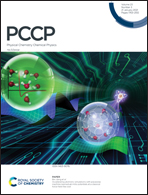Quantum spin Hall insulators and topological Rashba-splitting edge states in two-dimensional CX3 (X = Sb, Bi)†
Abstract
Two-dimensional topological materials attracted intense interest in condensed matter physics due to their topologically protected edge states and potential applications in electronic devices. Here, based on first-principles calculations, we found that a two-dimensional CX3 (X = Sb, Bi) monolayer is a quantum spin Hall insulator with a large band gap. With the strong spin–orbit coupling effect, CX3 exhibits noticeable bulk band gaps up to 470 meV, sufficiently large for realizing the quantum spin Hall effect at room temperature. The topological characteristic is confirmed by the Z2 invariant since the system preserves time-reversal symmetry. Particularly, the CSb3 monolayer displays unique topologically entangled Rashba-splitting edge states, resembling nearly free-electron quadratic dispersion. Such topologically entangled Rashba-like edge states derive from the spin–orbit coupling effect and inversion symmetry breaking on the edges. Moreover, we demonstrate that the topological properties are perfectly preserved in the CX3 monolayer even with a h-BN substrate. The nontrivial quantum spin Hall state in the CX3 monolayer will provide possibilities for studying a novel phenomenon of edge states and potential applications in low-dissipation electronic devices.



 Please wait while we load your content...
Please wait while we load your content...